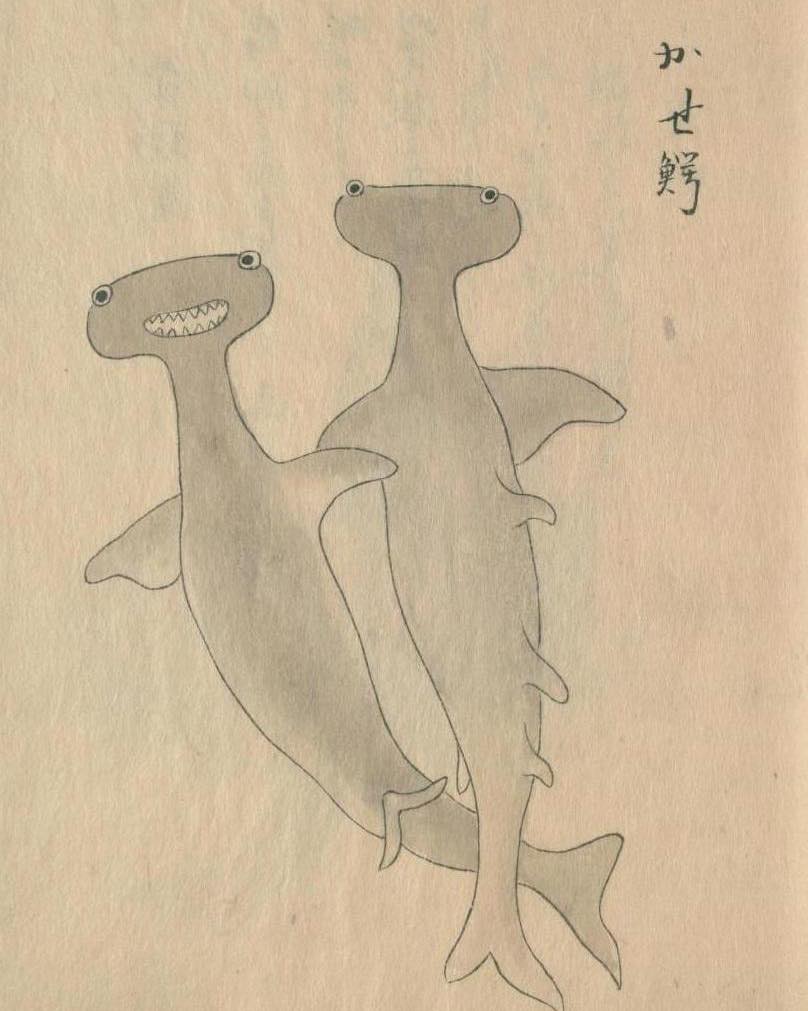The Oki National Products Illustration Notes, created during Japan’s Edo Period in 1735 CE, provide an extraordinary glimpse into the artistic and scientific documentation of marine life during this time. Among the many depictions in this collection, the illustrations of hammerhead sharks stand out as a fascinating intersection of art, culture, and natural history. These depictions offer insight into how people in Edo-period Japan perceived and recorded marine creatures, particularly a species as distinctive as the hammerhead shark.

The Edo Period (1603–1868) was a time of significant cultural and artistic development in Japan. This era saw the flourishing of various art forms, including ukiyo-e (woodblock prints), meticulous hand-painted scrolls, and detailed scientific illustrations. Japan was in a period of relative isolation under the Tokugawa shogunate, yet its artistic and scholarly traditions thrived, particularly in the documentation of natural history. The Oki National Products Illustration Notes—a collection dedicated to cataloging regional flora, fauna, and marine species—serves as a valuable historical record of this period’s engagement with the natural world.
The hammerhead shark, known for its unique T-shaped head, has long intrigued both scientists and artists. In the Oki National Products Illustration Notes, the depictions of these sharks are highly detailed, capturing the distinct features of the species. The broad, flat head, characteristic eyes set far apart, and sleek body structure are all meticulously rendered, suggesting that the artists and scholars responsible for these illustrations had firsthand knowledge of these creatures—likely through direct observation or through accounts from local fishermen.
These illustrations were not merely artistic endeavors; they were part of a broader scientific effort to catalog Japan’s marine biodiversity. The Edo period saw significant advancements in honzōgaku (natural studies), influenced by both indigenous knowledge and limited external scientific contact, particularly through the Dutch traders who maintained a presence in Japan via the island of Dejima. Japanese scholars combined careful observation with artistic skill to create accurate depictions of marine life, and the hammerhead shark illustrations in the Oki National Products Illustration Notes reflect this meticulous approach.
One of the remarkable aspects of these depictions is their accuracy despite the limited scientific tools available at the time. The hammerhead shark’s distinctive cephalofoil (hammer-shaped head) is not exaggerated or misrepresented, as might be seen in some other historical marine illustrations. Instead, the drawings show an understanding of the shark’s true form, which indicates that Edo-period Japanese scholars had a keen observational eye and an appreciation for marine biology.
Beyond their scientific significance, these illustrations also provide cultural insights. Sharks, including the hammerhead, held various symbolic meanings in Japanese folklore and artistic traditions. In some regions, sharks were viewed as powerful and sometimes ominous creatures, representing both danger and strength. Fishermen often regarded sharks with a mix of fear and reverence, recognizing them as formidable predators of the sea. The inclusion of hammerhead sharks in a national documentation project suggests that these creatures were of particular interest—either for their unique appearance, their role in the ecosystem, or their potential economic importance as a resource for fishing communities.
Additionally, the artistic techniques used in these depictions reflect the stylistic influences of the Edo period. The use of delicate line work, shading, and attention to anatomical details align with the broader artistic trends of Japanese naturalist illustration. Unlike the more stylized and imaginative creatures found in mythological or folklore-inspired artwork, these sharks are rendered with a level of realism that underscores the Edo period’s commitment to documenting the natural world as accurately as possible.
The presence of hammerhead sharks in Japanese waters, particularly around the Oki Islands, further supports the inclusion of these illustrations in the Oki National Products Illustration Notes. The Oki region, known for its rich marine biodiversity, would have provided ample opportunity for scholars and artists to observe various sea creatures, including sharks. The careful documentation of these species suggests that Edo-period naturalists had a strong interest in understanding the local marine ecosystem and its inhabitants.
It is also important to consider how these illustrations contributed to broader Edo-period knowledge-sharing. The Oki National Products Illustration Notes were likely used for educational purposes, allowing scholars, fishermen, and officials to familiarize themselves with regional wildlife. By documenting hammerhead sharks alongside other marine species, these records provided valuable reference material that helped bridge the gap between traditional knowledge and emerging scientific methodologies in Japan.
Moreover, these depictions highlight the Edo period’s early engagement with what we might now consider marine biology. While formal ichthyology (the study of fish) had yet to develop as a distinct scientific discipline in Japan at that time, these illustrations demonstrate a methodical approach to observing and recording aquatic life. This practice laid the groundwork for future generations of Japanese scientists and naturalists, contributing to a growing understanding of marine species long before modern taxonomy and classification systems were fully established.
The legacy of the Oki National Products Illustration Notes and its depictions of hammerhead sharks extends beyond the Edo period. Today, these historical records serve as a valuable reference for historians, biologists, and art scholars alike. They provide not only a glimpse into the biodiversity of 18th-century Japan but also a testament to the meticulous documentation efforts undertaken by Japanese scholars and artists of the time. The combination of scientific observation and artistic skill seen in these illustrations remains a significant contribution to the historical study of marine life.
In conclusion, the hammerhead shark illustrations in the Oki National Products Illustration Notes offer an exceptional example of Edo-period Japan’s dedication to documenting the natural world. These images reflect a careful balance of artistic craftsmanship and scientific inquiry, showcasing the period’s unique approach to natural history. Whether viewed through the lens of art, science, or cultural history, these depictions remain a fascinating testament to Japan’s rich intellectual and artistic traditions.





